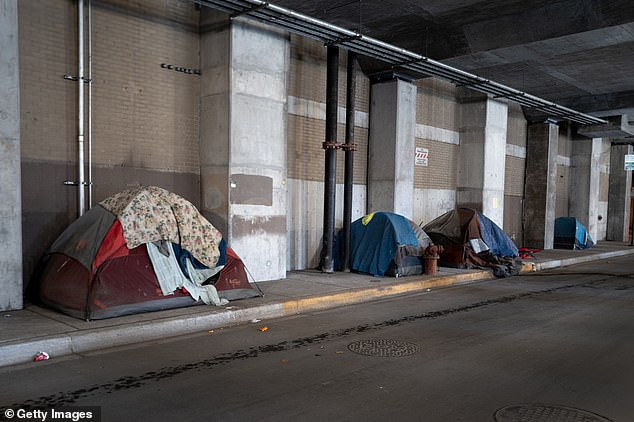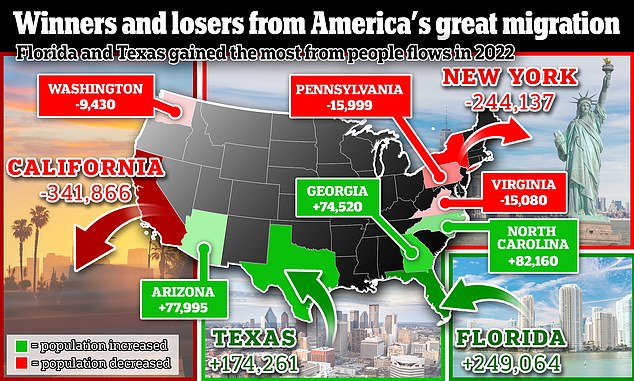The most dysfunctional state in America? Soaring unemployment, sky-rocketing debt and punishing taxes send residents fleeing
Move over California and New York and a new state is vying for the “most dysfunctional” state in America.
Illinois is grappling with a series of issues that have led to an increase in the number of residents leaving the state.
The state is struggling to create jobs and the state’s pension debt has risen to nearly $150 billion. Meanwhile, the population has declined, which has negative consequences for tax revenues.
Conservative think tanks have now grouped Illinois with other blue states such as New York and California, which have also experienced an exodus amid issues ranging from immigration to crime.
‘Unemployment rates are very high; wage growth is lagging behind most other states,” said Bryce Hill, director of fiscal and economic research at the Illinois Policy Institute.
Hill told the Daily caller: ‘The Census Bureau has reported that residents are leaving the state en masse, by the hundreds of thousands each year, so much so that the state’s population has actually declined over the past decade.
Illinois is grappling with a series of issues that have led to an increase in the number of residents leaving the state – which has been touted as one of the “most dysfunctional” states in America. Pictured: Chicago, Illinois’ most populous city

Members of the FBI Evidence Response Team Unit investigate in downtown Highland Park, Illinois, on July 5, 2022, the day after a deadly mass shooting during a Fourth of July parade

Tents used by homeless people line an underground sidewalk downtown on April 22, 2024 in Chicago, Illinois
“So by any measure, quantitatively by the results, the Illinois economy is lagging.”
Census Bureau data shows the population fell by around 32,826 people in the year to July 2023. The population of 12,549,689 was also over a quarter of a million less than in April 2020.
Illinois’ pension debt also grew by $2.6 billion last year to $142.3 billion in unfunded liabilities, state data show.
A September 2022 report from Equable states that it has the worst-funded state pension in the country after Kentucky.
State auditors also predict that the country will have a budget deficit of $891 million in the coming fiscal year.
Governor JB Pritzker has defended his record in office, telling a State of the State and budget address in February that his administration has grown Illinois’ economy to more than $1 trillion.
Illinois’ unemployment rate is also the fifth highest in the country at 4.8 percent.

Governor JB Pritzker has defended his record, telling a State of the State and Budget address in February that his administration has grown Illinois’ economy to more than $1 trillion.
But Hill said the budget deficit combined with migration out of the state will deepen the problems.
“So the state expects budget deficits for the coming years, in the absence of changes in expenditure or revenue, which will certainly be affected by the migration,” he added.
“Migrants take more than $10 billion in revenue out of the state as we lose people to internal migration, so it certainly impacts not only the state’s pocketbook, but local tax revenue as well.
“But they are not the root cause of the state’s budget stress because the state also faces another very big problem, unfunded pension liabilities that are draining state and local government budgets, crowding out funding and taking up large amounts of money. sources of income.’
The situation in Illinois follows similar trends in New York and California, both of which have lost hundreds of thousands of residents in recent years — with many of them moving to low-tax states such as Florida and Texas.
U.S. Census Bureau data released last October showed that California and New York combined lost nearly 1.4 million residents in 2022.
Florida gained about 249,064 people during the same period, while Texas had 174,261 more new arrivals than those who left.

A Chicago police officer detains a migrant near a shelter at the former Standard Club in Chicago on April 16, 2024

U.S. Census Bureau data released last October showed that California and New York combined lost nearly 1.4 million residents in 2022. Overall, California recorded a net loss of 341,866 people, compared to 244,137 for New York.
Overall, California had a net loss of 341,866 people, compared to 244,137 for New York.
Population experts have long studied U.S. population flows. Some explanations for interstate migration patterns are widely accepted.
Americans move primarily for better jobs, affordable housing, a cheaper cost of living and to lower their tax bills.
Some are moving away from areas with high crime, homelessness and the sight of drug addicts stumbling on sidewalks — a growing problem in parts of California and Oregon.
Social problems are a headache for officials in cities like San Francisco and Portland.
William Frey, a demographer at the Brookings Institution think tank, said Americans are mainly traveling for money.
“Interstate movers are motivated by work, housing and family reasons,” Frey told DailyMail.com.
Major relocation trends in recent years have seen New Yorkers flocking to Florida and Californians choosing Texas, he noted.
